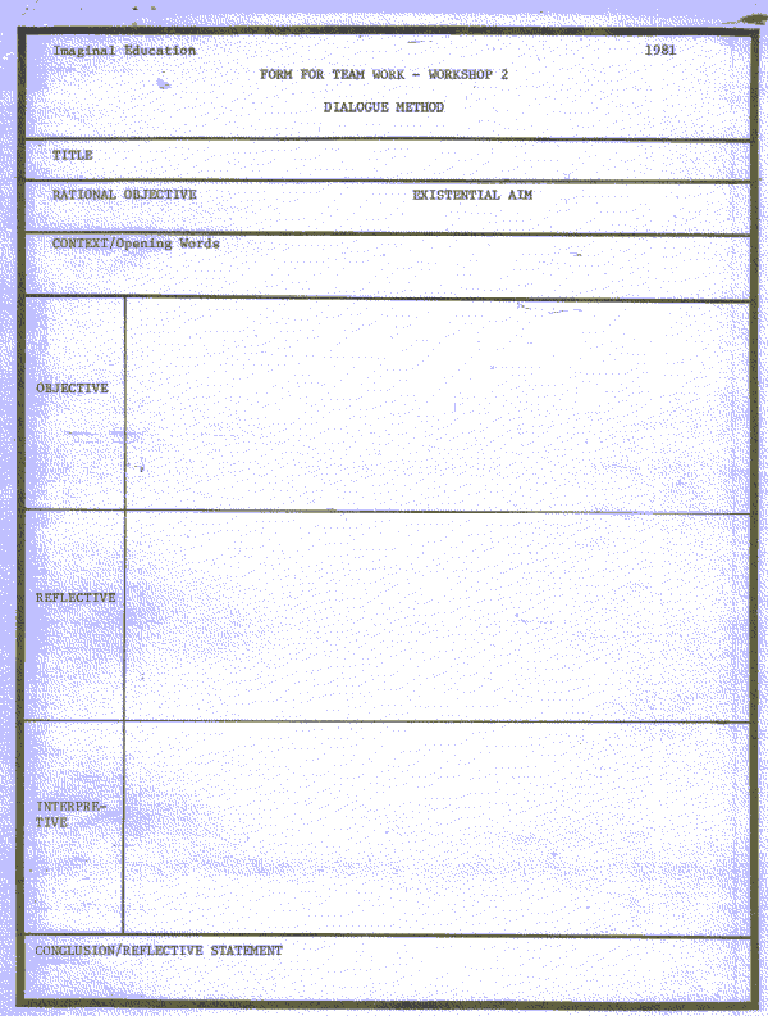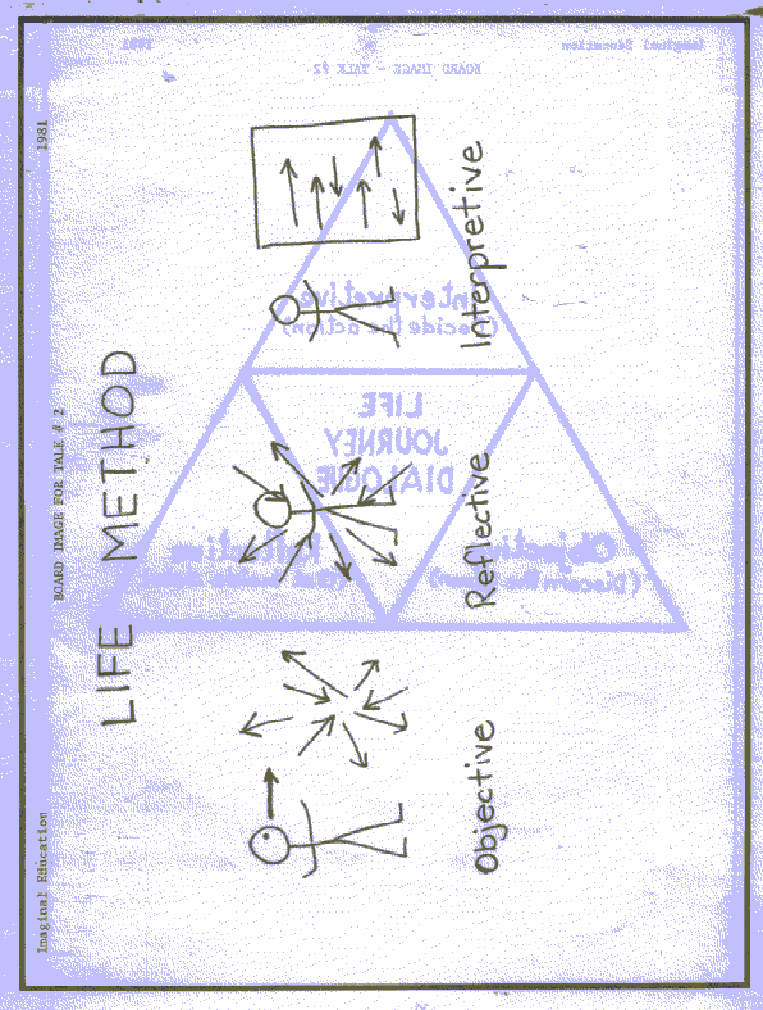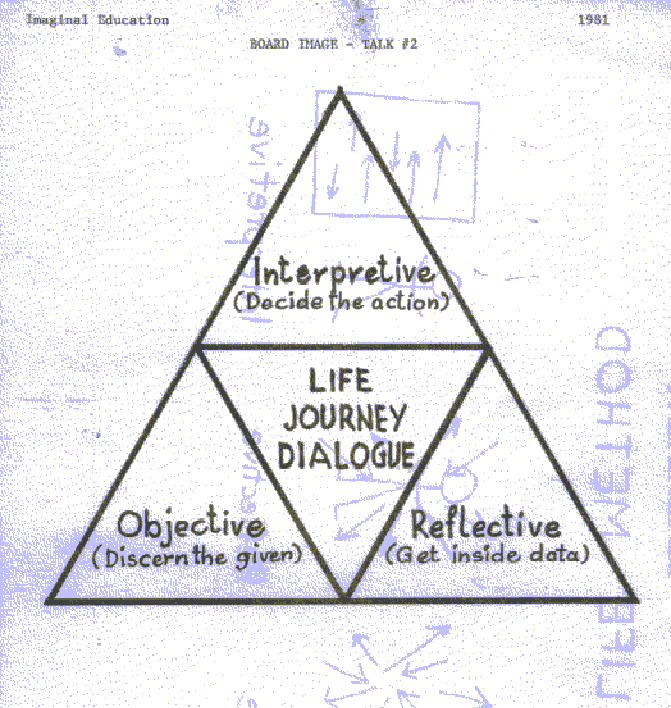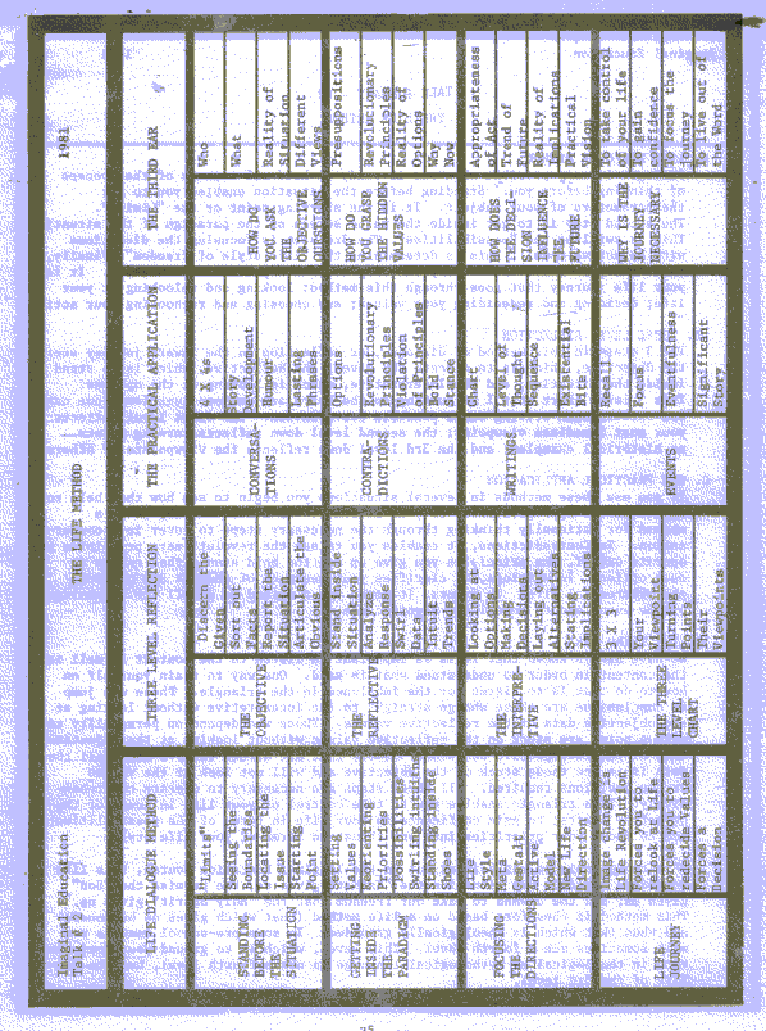 Imaginal
Education
Imaginal
EducationImaginal Education
1981
MEAL CONSTRUCT II
ART FORMS FOR NEW UNDERSTANDINGS
MEAL
OBJECTIVE
RATIONAL OBJECTIVE
To see changing images as a life process.
EXISTENTIAL AIM
To experience the effectivity of the art form method in releasing new self understanding.
CONTEXT
During this course we will jump into the ring and then reflect on what happened to you. We will begin by singing. We've all come from different jobs and situations that we're involved in during the day. We have found that singing together helps to build a corporate group to move into the next task.
SONG
(Select a song appropriate to the group.)
RITUAL
Repeat after me:
ACTION REMOVES THE DOUBT THAT THEORY CANNOT SOLVE.
MEAL
Let us eat this meal on behalf of the Poets who provide images for people to live authentically in their lives.
CONVER
SATION
Art forms like stories, whether printed, vocal, or visual, can be a great tool in offering new images. Listen to this story.
Read, "LongHandled Broom."
objective
1. Words, scenes, characters
2. Describe what happened.
reflective
3. Where did the shifts take place in the story? Describe them.
interpretive
4. What decision was Emma demanding of the village?
5. What can be learned from this story about changing images?
SEND OUT
Repeat after me:
ACTION REMOVES THE DOUBT....THAT THEORY CANNOT SOLVE.
ANNOUNCEMENTS
Imaginal Education
: _
1981
SESSION II MEAL CONVERSATION
THE LONG HANDLED BROOM
Three weeks after the monsoon ended, the older people in the village began to sweep out their own homes, the paths leading from their houses to the road, and finally the road itself. This sweeping was inevitably done by older people. They used a broom made of palm fronds. It had a short handle, maybe two feet long, and naturally they bent over as they swept.
One day, as Emma was watching the wrinkled and stooped woman from the next house sweep the road, things fell into place. She went out to talk to the woman.
"Grandmother, I know why your back is twisted forward," she said, "It's because you do so much sweeping bent over that short broom. Sweeping in that position several hours a day gradually molds you into a bentposition. When people become old their muscles and bones are not as flexible as when they were young."
"Wife of the engineer, I do not think it is so," the old lady answered softly. "The old people of Southern Sarkhan have always had bent backs."
"Yes, and I'll bet that they all got them from sweeping several hours a day with a shorthandled broom," Emma said, "Why don't you put a long handle on the broom and see how it works?"
"Brooms are not meant to have long handles," the old lady said matteroffactly. "It has never been that way. I have ever seen a broom with a long handle, and even if the wood were available, I do not think we would waste it on long handles for brooms. Wood is very scarce in Chang Dong."
Emma knew when to drop a conversation. She had long ago discovered that people don't stop doing traditional things merely because they are irrational. She also knew that when people are criticized for an action, they stubbornly persist in continuing to do it.
The handles the Sarkhanese used for their brooms came from a reed with a short strong stem about two feet long. For centuries this reed had been used; and, centuries ago people had given up looking for anything better. It was traditional for brooms to have short handles, and for the brooms to be used exclusively by people too old to work in the rice fields. But Emma wasn't bound by centuries of tradition, and she began to look for a substitute for the short handles.
One day she found what she was after. She was driving the jeep down a steep mountain road about forty miles from Chang Dong. Suddenly she jammed on the brakes. Lining one side of the road for perhaps twenty feet was a reed very similar to the short reed that grew in Chang Dongexcept that this reed had a strong stalk that rose five feet into the air before it thinned out.
"Homer," she ordered, "climb out and dig me up a halfdozen of those reeds. But don't disturb the roots."
When she got back to Chang Dong she planted the reeds beside her house and tended them carefully. Then, one day, when several of her neighbors were in her house she casually cut a tall reed, bound the usual coconut fronds to it, and
The Long Handled Broom p. 2
began to sweep. The women were aware that something was unusual, but for several minutes they could not figure out what was wrong. Thenone of the women spoke. "She sweeps with her back straight," the woman said in surprise. "I have never seen such a thing."
Emma did not say a word. She continued to sweep right past them, out on the front porch, and then down the walk. The dust and debris flew in clouds; and everyone watching was aware of the greater efficiency of being able to sweep while standing up.
Emma, having finished her sweeping, returned to her home and began to prepare tea for her guests. She did not speak to them about the broom, but when they left, it was on the front porch, and all of her guests eyed it carefully as they departed.
The next day when Emma swept off her porch, there were three old grandmothers who watched from a distance. When she was finished Emma leaned her longhandled broom against the clump of reeds which she had brought down from the hills.
The next day, perhaps ten older people, including a number of men, watched Emma as she swept. This time when she was finished, an old man, his back bent so that he scurried with a crablike motion, came over to Emma.
"Wife of the engineer, I would like to know where I might get a broom handle like the one you have," the man said, "I am not sure that our shorthandled brooms have bent our backs like this but I am sure that your way of sweeping is a more powerful way."
Emma told him to help himself to one of the reeds growing beside the house. The old man hesitated.
"I will take one and thank you; but if I take one, others may also ask, and soon your reeds will be gone."
"It is nothing to worry about, old man," Emma said. "There are many such reeds in the hills. I found these by the stream at Nanghsa. Your people could walk up there and bring back as many as the village could use in a year on the back of one water buffalo." The old man did not cut one of Emma's reeds. Instead he turned and hurried back to the group of older people. They talked rapidly, and several hours later Emma saw them heading for the hills with a water buffalo in front of them.
Soon after, Homer completed his work in Chang Dong, and they moved to Rhotok, a small village about seventy miles to the east. And it was not until four years later, when Emma was back in Pittsburgh, that she learned the final results of her broomhandle project. One day she got a letter in a large handsome yellow bamboo paper envelope. Inside, written in an exquisite script, was a letter from the headman of Chang Dong:
LongHandled Broom pg 3
Wife of the engineer: I am writing you to thank you for a thing that you did for the old people of Chang Dong. For many centuries, longer than any man can remember, we have always had old people with bent backs in this village. And in every village that we know of the old people have always had bent backs.
We had always thought this was a part of growing old, and it was one of the reason that we dreaded old age. But, wife of the engineer, you have changed all that. By the lucky accident of your longhandled broom you showed us a new way to sweep. It is a small thing, but it has changed the lives of our old people. For four years, ever since you have left, we have been using the long reeds for broom handles. You will be happy to know that today there are few bent backs in the village of Chang Dong. Today the backs of our old people are straight and firm. No longer are their bodies painful during the months of the monsoon.
This is a small thing, I know, but for our people it is an important thing.
I know you are not of our religion, wife of the engineer, but perhaps you will be pleased to know that on the outskirts of the village we have constructed a small shrine in your memory. It is a simple affair; at the foot of the altar are these words: "In memory of the woman who unbent the backs of our people." And in front of the shrine there is a stack of the old short reeds which we used to use.
 Imaginal
Education
Imaginal
Education
1981
TALK SUMMARY #2
THE LIFE METHOD
A. LIFE DIALOGUE METHOD
Dialogue is only possible when one is ready to hold all aspects of the process of thinking before you. Standing before the situation enables you to set the parameters of your subject. It is the starting point or the "Limits". The second step is to get inside the value screen or the paradigm of the situation. This is swirling the "possibilities". The 3rd stepis focusing the directions with an active model. This is determining the "life style offreedom". Finally, this dialogue method is not only the only one for a particular situation. It is your life journey that goes through this method: looking and re-looking at your
life; deciding and re-deciding your values; and choosing and re-choosing your actions.
** Although this is not pointed out in the Imaginal Education Course, this life method is based on the situation the "Father" gives us, the promise the "Son" gives us, and the demand to take our freedom that the "Holy Spirit" gives us. This method is therefore based on a life method (that which gives us humanness) and thus that which is theologically grounded. In some preschool manuals you will sometimes see a fourth level. This level, which is to ground your conversation in theological or mythological language is not a fourth level, but the 3rd part of the 3rd level.
C. THE PRACTICAL APPLICATION
If you use these methods in several situations you begin to see how they help to determine the appropriateness of your activity. In conversations, it is a method for rationally thinking through the necessary steps to cover in a conversation. In Contradictions, it enables you to see the revolutionary principles you operate out of, the principles you give up and the bold stance that exists in each option. In writings, it clarifies your sequence of thought and provides the existential bite. In Events, it gives you a method to recall the happenings of the event and to reveal the significance.
B. THREE LEVEL REFLECTION
The 3 steps in this method of dialogue, or reflection on the inward journey are: the Objective, which is to discern the given; the Reflective, which is to stand inside the situation; and the Interpretive, which is looking at the options. This 3 level chart that I am putting on the board are various questions one can ask oneself when writing out a possible conversation. The first level reflects your most immediate viewpoint; the second level down reflects turning points
or historical examples; and the 3rd level down reflects the viewpoints of others.
D. THE THIRD EAR
We have always known that it is as important to listen to the context as well as the content in order to understand what is said. One way to train yourself on how to do that is to listen for the imbalance in the triangle. Those who jump
to conclusions are those who go straight to the interpretive without looking at the objective data or the reflective values. Those who depend on personality to make a point are stuck on the reflective values without looking at the objective
data or the interpretive decisions. Those that are afraid to move until all the data is in are those stuck on the objective and will not look at the values or the decisions required. All three steps are necessary to operate comprehensively. This triangle enables you to take control of your life in terms of the objective limits; to gain confidence in your life in terms of the possibilities; and to focus your priorities into one thrust in terms of your life style.
Imaginal Education READING WITH TALK # 2 1981
THE IMMENSE JOURNEY
by Loren Eiseley
_
Some lands are flat and areascovered, and smile so evenly up at the sun that they seem forever youthful, untouched by man or time. Some are torn, ravaged and convulsed 1ike the features of profane old age. Rocks are wrenched up and exposed to view; black pits receive the sun but give back no light.
It was to such a land I rode, but I rode to it across a sunlit, timeless prairie over which nothing passed but antelope or a wandering bird. On the verge where that prairie halted before a great wall of naked sandstone and clay, I came upon the Slit. A narrow crack worn by some descending torrent had begun secretly, far below the prairie grass, and worked itself deeper and deeper into the fine sandstone that led by devious channels into the broken waste beyond. I rode back along the crack to a spot where I could descend into it, dismounted, and left my horse to graze.
The crack was only about bodywidth and, as I worked by way downward, the light turned dark and green from the overhanging grass. Above me the sky became a narrow slit of distant blue, and the sandstone was cool to my hands on either side. The Slit wee a little sinister like an open grave, aasum1ng the dead were enabled to take one last look for over me the sky seemed already as far off as some future century I would never see.
I ignored the sky, then, and began to concentrate on the sandstone walls that had led me into this place. It wee tight and tricky work, but that cut wee a perfect cross section through perhaps ten million years of time. I hoped to find at least a bone, but I was not quite prepared for the sight I finally came upon. Staring straight out at me, as I slid farther and deeper into the green twilight, was a skull embedded in the solid sandstone. I had come at just the proper moment when it was fully to be seen, the white bone gleaming there in a kind of ashen splendor, water worn, and about to be ground away in the next long torrent.
It was not, of course, human. I was deep, deep below the time of man in a remote age near the beginning of the reign of mammals. I squatted on my heels in the narrow ravine, and we stared a little blankly at each other, the skull and I. There were marks of generalized primitiveness in that low, pinched brain case and grinning jaw that marked it as lying far back along those converging roads where, as 1 shall have occasion to establish elsewhere, cat and man and weasel must leap into a single shape.
It was the face of a creature who had spent his days following his nose, who was led by instinct rather than memory, and whose power of choice was very small. Though he was not a man, nor a direct human ancestor, there was yet about him, even in the bone, some trace of that low, snuffling world out of which our forebears had so recently emerged. The skull lay tilted in such a manner that it stared, sightless, up at me as though I, too, were already caught a few feet above him in the strata and, in my turn, were staring up and at that strip of sky which the ages were carrying farther away from me beneath the tumbling debris of falling mountains. The creature had never lived to see a man, and I, what was it I was never going to see.
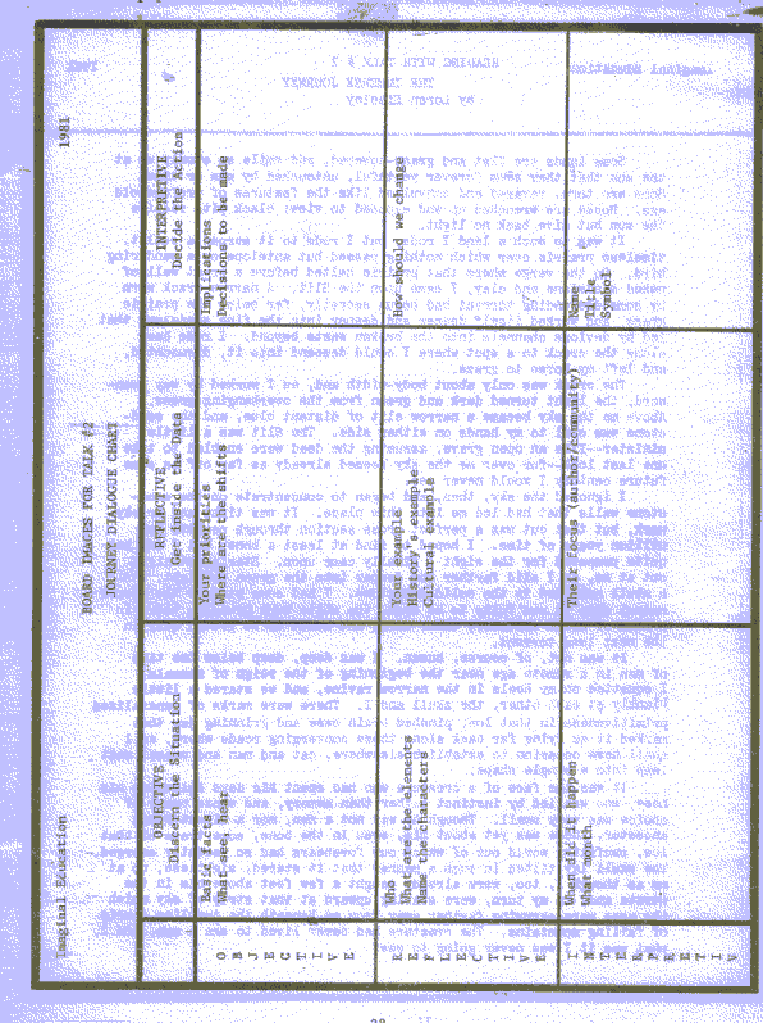 Imaginal
Education
Imaginal
Education
1981
WORKSHOP # 2
DIALOGUE METHOD
RATIONAL OBJECTIVE: To practice the life method of
reflection.
EXISTENTIAL AIM: To see the possibility of reflecting in depth in any situation.
STEP
PROCEDURES
CONTEXT
We want to create an art form conversation using the dynamics of dialogue talked about in the talk. Hand out "Journey Dialogue" charts. Briefly walk through the dynamics of the 3 X 3. The 1st chart will be to hold our initial brainstorm work. The 2nd chart is for the final draft of our conversation.
TEAM
ASSIGNMENT'
1.
Break into groups of 45 people. (Either the same teams as in session 1 or a new configuration with common working situations. A bank president and a school teacher on the same team will not be helpful.)
2. Whole group decide on arenas for their conversations, like:
a. a conversation on a work situation.
b. a way of discerning a contradiction or block that they are
= dealing with.
c. writing a proposal on a particular subject.
d. reflecting on an event (choose subject)
artform conversation on an awe object or a story reflection
(choose subject.)
TEAM
WORK
1. Construct a conversation dealing with your arena using first the brainstorm form and then the conversation form.
2. Work with the Rational Objective and Existential Aim first.
3. Take 45 minutes for this work and appoint a scribe to record the final selection of questions.
TEAM
REPORTS
1. Each team report (if time is a factor you may ask just for
highlights from their work)
2. Are there questions of clarity on the reports?
3. Which questions or lines most struck you? (you want 1015 answers)
4. Look at each report and ask: Which images will be changed as the result of this work?
REFLECTION
1. What has shifted your image since the beginning of this session
(including the talk)
2. How will this session be useful how might you use it?
3. What was most helpful in this session? leas helpful?
4. Assign someone to type
up the reports.

